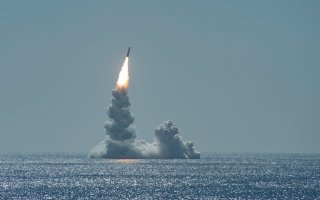Hypersonic Missiles: Not Ready for War Just Yet?
Development still has a way to go.
Key Point: Skepticism is in order.
Don’t get too excited about hypersonic weapons, one prominent U.S. defense journalist advised. According to him, we still don’t know for sure whether the Mach-5-plus munitions actually work.
Sure, Russia and China are moving quickly to deploy hypersonic anti-ship and land-attack missiles. The U.S. armed forces meanwhile are collaborating on a family of Mach-5 weapons that could enter service in the early 2020s.
The U.S. Navy already is considering modifying submarines and destroyers to launch the big, fast munitions. The U.S. Air Force wants to combine hypersonic missiles with its new concept for a big, heavily-armed “arsenal plane.”
But skepticism is in order, David Larter advised in a November 2019 column in Defense News. “The catch is that none of this stuff works yet,” Larter wrote. “I want to emphasize that all of what we’re talking about here are prototypes.”
Larter quoted Mike Griffin, a top Pentagon acquisitions official and a major advocate of hypersonic weapons.
“Let’s just propose a thought experiment,” Griffin said in September 2019. “Which do you think the Chinese leadership would fear more: 2,000 conventional strike missiles possessed by the United States and its allies in the western Pacific capable of ranging Chinese targets, or one new carrier? Because those two things cost about the same amount of money. Those are the kinds of questions we need to be asking ourselves.”
“Now Griffin wasn’t saying that we should get rid of carriers,” Larter pointed out. “Indeed, he said we need to keep investing in them, but that adversaries understand that system.” Still, it’s worth pointing out the problems in Griffin’s notion of swapping flattops for thousands of hypersonic missiles.
Larter cited “missile enthusiast” Tom Karako from the Center for Strategic and International Studies in Washington, D.C. Karako “raised the very excellent point that you will likely need airborne sensors to target these things in the future,” Larter explained.
“This debate has been around a long time, and what the military has found time and again is that first of all you have to get stuff there, and that’s why the U.S. tends to be platform-heavy,” Karako said. “It’s one thing to say, ‘Let’s just shoot a bunch of missiles from Hawaii,’ but it’s not just about shooting missiles — you have to have the complete kill chain.”
“You have to know where they are going to go, and you have to hope your target hasn’t moved since you pulled the trigger. So it’s probably prudent to have a mix of things.”
Bryan Clark, an analyst at the Center for Strategic and Budgetary Assessments in Washington, D.C., likewise is skeptical of what Larter described as “the hypersonics craze.” “He is certainly not bullish on the future of the boost-glide systems that Griffin proposed as a possible alternative to carriers for power projection,” Larter wrote.
“These boost-glide prompt-strike weapons are really designed to have a strategic effect,” Clark explained.
There are a small number of weapons, they are really expensive, so you are not going to hit a bunch of targets with them. So even one weapon that’s a hypersonic weapon could still get shot down. You may not be able to generate a bunch of effects with them because they cost so much that you aren’t going to do the thing where you overwhelm the air defenses and come in from multiple angles with hypersonics because you don’t have enough of them.
The warhead itself may be good for hitting a point target or maybe moderately hard targets, but it’s not going to be good for hitting very hard targets, buried targets or area targets. So, it’s going to have a limited range of applications and because you have so few of them.
“In real, operational scenarios, having these weapons doesn’t make a huge difference,” Clark concluded. “It’s unlikely that that one target is going to be valuable enough to shut down the other side’s war effort.”
Larter echoed questions the Congressional Research Service posed in regard to hypersonic weapons. “What mission(s) will hypersonic weapons be used for?” CRS asked. “Are hypersonic weapons the most cost-effective means of executing these potential missions? How will they be incorporated into joint operational doctrine and concepts?”
“Given the lack of defined mission requirements for hypersonic weapons, how should Congress evaluate funding requests for hypersonic weapons programs or the balance of funding requests for hypersonic weapons programs, enabling technologies and supporting test infrastructure? Is an acceleration of research on hypersonic weapons, enabling technologies or hypersonic missile defense options both necessary and technologically feasible?”
David Axe served as Defense Editor of the National Interest. He is the author of the graphic novels War Fix, War Is Boring and Machete Squad. This article first appeared in 2019 and is reprinted here due to reader interest.
Image: U.S. Navy / Flickr

